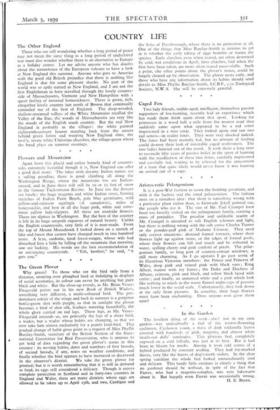The Green Plover
Why green? To those who see the bird only from a distance, strutting over ploughed land or indulging in displays of aerial acrobatics, its colour can never be anything but pure black and white. But the close-up reveals, as Mr. Brian Vesey- Fitzgerald points out in his new Book of British Waders, something very different, a multi-coloured bird. The pre- dominant colour of the wings and back in summer is a gorgeous bottle-green shot with purple, so that in sunlight the plover becomes a bird of shot silk, feathers watering beautifully, the whole glory carried on red legs. These legs, as Mr. Vesey- Fitzgerald reminds us, are primarily the legs of a shore bird, a wader, but a wader whose habits are changing, so that we now take him almost exclusively for a purely land-bird. This gradual change of habit gives point to a request of Miss Phyllis Barclay-Smith, secretary of the British Section of the Inter- . national Committee for Bird Preservation, who is anxious to get hold of data regarding the green plover's status in this country : its nesting habits, dates and numbers of first broods, of second broods, if any, notes on weather conditions, and finally whether the bird appears to have increased or decreased in the observer's district. We take the green plover for granted; but it is worth remembering that it is still in demand as food, its eggs still considered a delicacy. Though it enjoys complete protection in Scotland and in forty-two counties in England and Wales, there are many districts where eggs are allowed to be taken up to April isth, and two, Cardigan and
the Soke of Peterborough, where there is no protection at all. One of the things that Miss Barclay-Smith is anxious to get at is whether the early taking of eggs benefits or harms the species. Early clutches, even when reared, are often destroyed by cold, wet conditions in April; later clutches, laid when the first have been taken, are more often reared successfully. Such a point, like other points about the plover's status, could be largely cleared up by observation. The plover nests early, and those who have any information about its habits should send details to Miss Phyllis Barclay-Smith, I.C.B.P., c/o Zoological Society, N.W. 8. She will be extremely grateful.


























































 Previous page
Previous page